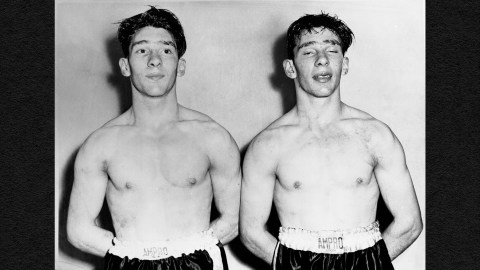What identical twin research reveals about criminality

- History is full of stories about identical twins who both engaged in criminal behavior.
- These twin criminals raise an intriguing question: If one twin turns to crime, is the other fated to as well? Scientists have distilled this question into a similar one: Is criminal behavior tied to one’s genes?
- Studies comparing identical and fraternal twins indeed suggest that the inclination to engage in criminal behavior is partly tied to one’s genes, though upbringing and environment also play a role.
On the morning of September 25, 2023, 35-year-old Samantha Jo Petersen struck an Amish buggy on a southeastern Minnesota road while driving her SUV back from work. Amid the strewn debris, two children lay dead. When police arrived, Sarah Beth Peterson, Samantha Jo’s identical twin sister, greeted them. She quickly confessed to the tragic accident. Samantha was nowhere to be found. Unbeknownst to the authorities, the sisters had switched positions to spare Samantha, who was high on methamphetamines, from prison.
Thanks to a couple of drive-by witnesses, the ruse was eventually uncovered. The sisters, who had extensive criminal histories before the incident, now both face years in prison.
Samantha and Sarah aren’t the only identical twins to have colluded in criminality. Prolific English poachers Albert and Ebenezer Fox planned and pursued all sorts of crimes in the late 1800s. The duo actually drove police to adopt fingerprinting to identify criminals. (Even identical twins have unique fingerprints.) During the 1960s, Ronnie and Reggie Kray featured prominently in the London gangster scene, committing murder, arson, and robbery, among many other misdeeds. In July 2003, Daniel and David DeWild teamed up to kill Daniel’s wife after she had filed for divorce.
These identical twin criminals raise an intriguing question: If one twin turns to crime, is the other fated to do so as well? Scientists have distilled this question into a similar one: Is criminal behavior tied to one’s genes?
The heritability of criminality
Over the years, scientists have used identical and fraternal twins to attempt to find an answer. In what’s become known as the “twin method” in criminology circles, scientists compared the crime concordance rates of identical and same-sex fraternal twins. If identical twins are more likely than fraternal twins to both have a criminal past or be law-abiding, that would suggest that genes play a role in criminality. After all, identical twins are 100% genetically similar while fraternal twins are 50% similar.
Indeed, studies dating back to 1930 show that identical twins are more likely than fraternal twins to both be criminals or both be law-abiding, suggesting at least some genetic basis. Scientists behind those early studies often opined that criminal behavior was almost entirely heritable. Their findings should be taken with a grain of salt, however. Many of these researchers were staunch eugenicists, believing that the human gene pool could be improved by controlling who gets to reproduce. They often advocated sterilizing criminals and even offenders’ children to reduce future crime rates. Some had Nazi ties.
Modern twin studies, conducted after the stain of eugenics was wiped away, have tended to find that the inclination to offend is around 50% heritable. While genes do predispose a person to criminality, environment and upbringing also play significant roles.
Comparing twins raised apart
Independent researcher Jay Joseph doesn’t even buy that, however. In an extensive review, he argued that using the “twin method” to probe criminal behavior’s genetic links is worthless. His main points? Identical twins are often raised to be more alike than fraternal twins. Moreover, identical twins have a tighter social bond.
“There is no reason to accept that the twin method records anything more than the greater environmental similarity… plus bias and methodological error,” he wrote.
In Joseph’s opinion, this leaves only one way to utilize twins to determine whether criminal behavior is tied to genes: Researchers must compare the criminal concordance between fraternal twins raised apart and identical twins raised apart.
Such a study has never been conducted, but with some effort, it could be. Between 1979 and 1990, researchers at the University of Minnesota tracked down 100 sets of twins who were separated in infancy and raised apart. They found that “on multiple measures of personality and temperament, occupational and leisure-time interests, and social attitudes, monozygotic [identical] twins reared apart are about as similar as are monozygotic twins reared together.” The scientists didn’t specifically assess each twin’s criminal behavior, but they could have. Considering the subjects’ striking similarities in personality, it is perhaps likely that some may have shared this dark connection. They, of course, weren’t telling.





